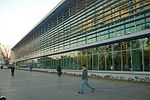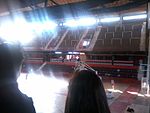Greater Rosario

Greater Rosario is the metropolitan area of the city of Rosario, in the province of Santa Fe, Argentina. This metropolis has a population of about 1.3 million (1,276,000 million inhabitants) thus being Argentina's third most populated urban settlement, after Buenos Aires and Córdoba.The Greater Rosario comprises Rosario itself (population about 910,000) and a large area around it, spreading in all directions except eastward (because of the Paraná River). Directly to the south it includes the city of Villa Gobernador Gálvez, with a population of about 75,000, at about 10 km (6.2 mi) from the center of Rosario. To the west and south-west there are several smaller towns and cities (Funes, Roldán, Pérez, Soldini); Roldán is 23 km from Rosario's center. These settlements were incorporated into the metropolis due to their vicinity to major roads leading into Rosario, and many people living there habitually commute to Rosario. The farthest end is to the north, following the coast of the river; from Rosario one finds, in succession and usually merging into each other, the towns of Granadero Baigorria, Capitán Bermúdez, Fray Luis Beltrán, San Lorenzo (already in a different departamento, with a population of over 40,000), and Puerto General San Martín, the last being at a distance of 35 km from Rosario. The north of the Greater Rosario is one end of an area traditionally called Cordón Industrial ("Industrial Corridor"), since it was traditionally a heavily industrialized productive region. The prelude to the economic crisis in the 1990s largely dismantled the industrial infrastructure and damaged agricultural exports. As of 2006 the recovery of national economy has revitalized them, but high levels of poverty and unemployment persist (the last official survey indicates that 27.4% of the population is under the poverty line).
Excerpt from the Wikipedia article Greater Rosario (License: CC BY-SA 3.0, Authors, Images).Greater Rosario
Zeballos, Rosario Nuestra Señora de Lourdes (Distrito Centro)
Geographical coordinates (GPS) Address Nearby Places Show on map
Geographical coordinates (GPS)
| Latitude | Longitude |
|---|---|
| N -32.951111111111 ° | E -60.666388888889 ° |
Address
Cárcel Unidad III
Zeballos 2951
S2002 Rosario, Nuestra Señora de Lourdes (Distrito Centro)
Santa Fe, Argentina
Open on Google Maps










